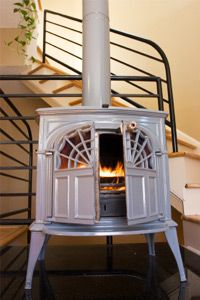What says, "This feels like home" to you? For many people, it's the image of a roaring fire. The glow of the dancing flames represents the perfect combination of tradition, beauty and coziness. It doesn't matter how many strides the home heating industry has made; few families want to gather around the furnace to open their Christmas stockings.
However, fireplaces are notoriously inefficient -- many of them actually make the rest of the house colder [source: EPA]. If you're concerned about heating bills or energy efficiency, you may have resigned yourself to the idea that the fireplace is only for special occasions.
Advertisement
A wood stove may be a fantastic solution. Wood stoves have evolved quite a bit from their potbellied ancestors. Today's wood stoves are clean and efficient, and have several environmental arguments on their side:
- They use cheap, renewable local fuel.
- They do not rely on petroleum.
- They produce far less pollution than a fireplace (although even a certified wood stove produces higher emissions than a natural gas stove). [source: EPA]
However, a wood stove is only as efficient as its installation. A proper installation considers the house's heating requirements and uses the natural movement of heat and air to get the most from the stove. A careless installation, on the other hand, might mean that your wood stove is no better than a fireplace.
This article answers all your burning questions about wood stoves: how to install them, how to put in a stovepipe and how to protect against house fires and other dangers.
